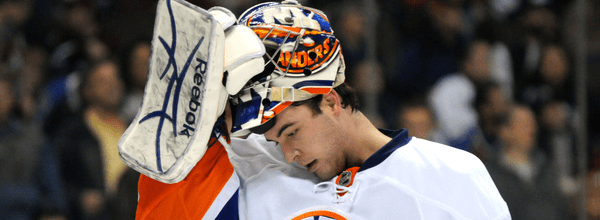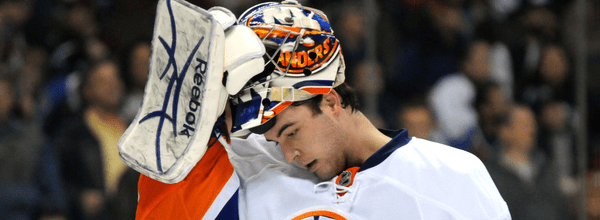How to Survive Fantasy Hockey Injuries


They happen every year. It is the scariest thing for any fantasy hockey GM to ever see. Their key player has just gone down with a significant injury for “X” amount of time. Everyone hears horror stories of that poor team owner who had like seven or eight guys all on the IR at once and had to drop some players that he would never dream on dropping just to fill a roster.
One of the best ways to check injuries quickly is to check the player updates section on the site or use the laid out list from TSN. Both of these are the most up-to-date lists aside from twitter, which we will touch on later.
The key is to look up and down this fine injury list. Some players are listed as probable, questionable, doubtful, and some have seemingly vanished in the case of Kurt Sauer. That is an honest to goodness true story as Sauer is completely out of hockey without barely an explanation.
Well unfortunately, fantasy hockey GM’s also now have a “can’t cut list”. So what is a CCL? Well it is a nice way of letting a GM know that the best they can do is put a guy on the IR if he cannot be cut. Lists like the CCL are only good to keep teams from just dropping everyone but does hurt the GM who is legitimately besieged by injuries.
Now think of all the injuries to some of the higher end talent in the National Hockey League. Zach Parise is pretty much out for the year with a torn meniscus that doubles for torn ligaments. Mark Streit was out for the year before it even began with a severe shoulder injury. There is a 50 percent increase over last year as far as the dreaded season end injuries before February 1st. That is a pretty marked increase and something that should be very highly noted.
A quick count of the “Injury Ticker” as we like to call it is at 117. That is a high number and does not include suspensions or players that are out for personal reasons like Rick Rypien, for example. Technically players like Pascal Leclaire and Rick DiPietro should not count either as they seem to be perpetually injured even when on the surface, healthy.
Also speaking of perpetual injuries, how about the common cold and flu? There is something to be said in checking the Weather Channel’s flu index report every so often. For example Mike Cammalleri currently has the flu, will miss at least a game and maybe more. If only players would learn to eat right, wash their hands, and take better care of themselves. Wouldn’t that be nice?
With all these crazy pitfalls, it seems like there is no way to survive all this injury madness. Well there are methods and none of them involve hiring the “Injury Ninja”, honest. Though there is a method to our madness via Twitter and why we plug a segment every show on Blog Talk Radio for The Program. The podcast airs Sunday and Wednesday Nights at 8pm ET as part of the critically acclaimed Fantasy Sports Channel.
STEP 1: Research your player injuries
Yes on the surface this sounds self serving but my show, The Program, has been extremely fortunate in getting these injuries right for the fantasy hockey GM. We alert to breaking news if a player is hurt and try to follow up on as many players as we can so YOU know what is going on. The Brad Stuart injury was something that happened live on the air and it was very clear the extent of the injury. We are also proud that some sports doctors and injury experts consult with us via twitter. That adds to the accurate information we can provide to help you win your fantasy league. Fantasy Sports hinges on who is able to play on your roster more than anything else; putting together that roster is incredibly paramount to success.
STEP 2: Make sure you know the rules
Nothing frustrates a manager more than not being able to put a guy on IR even though he is hurt. If you know beforehand that certain players just will not go on the IR for a variety of reasons, a manager can plan ahead and make proactive moves instead of just sitting there and excruciatingly wait for the day the little “O” or “IR” appears. A few major platforms that are usually guilty in driving the fantasy hockey GM insane with this. Keep vigilant and if you know one of your players is hurt, or several, check the injury lists daily for the latest.
STEP 3: Use Twitter? #fantasyhockey
Yes, use twitter plenty. Twitter, when used right, is a vast resource where a lot of information is fired out over a very short amount of time. Yes that has several considerable drawbacks but information is real time and that is crucial to success. Even the “Injury Ninja” has been known to put some knowledge out there on injuries and injury watches as well. Social media is very wise to use if done right and Twitter leads the way without question. To ignore it, is very foolish to say the least.
STEP 4: Check Waiver Wires Everyday
Please do this. People will try to sneak players across so to speak and a great way to sometimes catch another GM napping is to snatch someone no one expects you to. If you are really good at spotting talent, waiver wires can save you from making those dreadful one sided trades that eventually ruin your chances for league domination. The key is to ask people not in your leagues as well. Other fantasy players may be able to notice things on waiver wires that you do not. Remember this while trying to also realistically assess your truest needs.
STEP 5: Play the percentages…
This is the last one honest. Injuries are generally unforeseen occurrences but some players are just more injury prone than others, right DiPietro? Even a certain goalie in New Jersey has started to break down a bit. So the last step in survival is to play the percentages, stay away from players that may just get hurt anyway or are just labeled “fragile”. Sure you may miss out on a player or two that can stay healthy but if you load your roster with several of these guys, odds are that at least one or two of them will miss considerable time on your squad. Sometimes it is best to not play the game but when you have to, play the percentages. They usually balance out in the end.
Next week we will have another “How To”. Hopefully this helps you dominate your fantasy leagues and if you have any questions at all, you can either comment here on the site. You can follow me @TheProgramBTR or via The Program at stevens8204@gmail.com. You can also follow the site on twitter @dailyfaceoff Good luck in all of your fantasy hockey leagues.